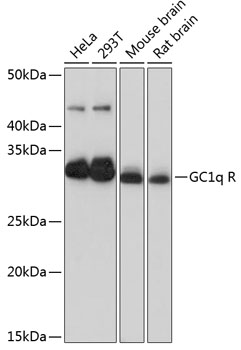Immunology Antibodies 3
Anti-GC1q R Antibody (CAB11292)
- SKU:
- CAB11292
- Product Type:
- Antibody
- Reactivity:
- Human
- Reactivity:
- Mouse
- Reactivity:
- Rat
- Host Species:
- Rabbit
- Isotype:
- IgG
- Antibody Type:
- Monoclonal Antibody
- Research Area:
- Immunology
Description
| Antibody Name: | Anti-GC1q R Antibody |
| Antibody SKU: | CAB11292 |
| Antibody Size: | 20uL, 50uL, 100uL |
| Application: | WB IHC |
| Reactivity: | Human, Mouse, Rat |
| Host Species: | Rabbit |
| Immunogen: | A synthesized peptide derived from human GC1q R |
| Application: | WB IHC |
| Recommended Dilution: | WB 1:500 - 1:2000 IHC 1:50 - 1:200 |
| Reactivity: | Human, Mouse, Rat |
| Positive Samples: | HeLa, 293T, Mouse brain, Rat brain |
| Immunogen: | A synthesized peptide derived from human GC1q R |
| Purification Method: | Affinity purification |
| Storage Buffer: | Store at -20°C. Avoid freeze / thaw cycles. Buffer: PBS with 0.02% sodium azide, 0.05% BSA, 50% glycerol, pH7.3. |
| Isotype: | IgG |
| Sequence: | Email for sequence |
| Gene ID: | 708 |
| Uniprot: | Q07021 |
| Cellular Location: | |
| Calculated MW: | 31kDa |
| Observed MW: | 31KDa |
| Synonyms: | GC1QBP, HABP1, SF2p32, gC1Q-R, gC1qR, p32 |
| Background: | The human complement subcomponent C1q associates with C1r and C1s in order to yield the first component of the serum complement system. The protein encoded by this gene is known to bind to the globular heads of C1q molecules and inhibit C1 activation. This protein has also been identified as the p32 subunit of pre-mRNA splicing factor SF2, as well as a hyaluronic acid-binding protein. [provided by RefSeq, Jul 2008] |
| UniProt Protein Function: | C1QBP: a multifunctional and multicompartmental protein involved in inflammation and infection processes, ribosome biogenesis, regulation of apoptosis, transcriptional regulation and pre-mRNA splicing. Originally identified via its binding interactions with Splicing Factor (SF-2). Multiple, diverse binding partners of C1QBP were subsequently identified, including the globular heads of complement component C1q, hyaluronic acid, selected protein kinases, the tumor suppressor ARF, and multiple antigens of bacterial and viral origin. Overexpressed in a number of cancer cell types, and has been implicated in the Warburg effect, whereby cancer cells shift their metabolism from oxidative phosphorylation to glycolysis. Inhibits the Mitochondrial Permeability Transition (MPT) pore, possibly serving a protective function against damage from oxidative stress. Binding to C1q inhibits C1. In complex with cytokeratin-1/KRT1 is a high affinty receptor for kininogen-1/HMWK. The secreted form may enhance both extrinsic and intrinsic coagulation pathways. The cell surface form may require docking with transmembrane proteins for downstream signaling which might be specific for a cell-type or response. Belongs to the MAM33 family. |
| UniProt Protein Details: | Protein type:Motility/polarity/chemotaxis; Receptor, misc.; Nucleolus; Mitochondrial Chromosomal Location of Human Ortholog: 17p13.3 Cellular Component: cell surface; cytoplasm; cytosol; membrane; mitochondrion; nucleus; plasma membrane Molecular Function:adrenergic receptor binding; complement component C1q binding; hyaluronic acid binding; kininogen binding; mRNA binding; protein binding; transcription corepressor activity; transcription factor binding Biological Process: blood coagulation, intrinsic pathway; immune response; mature ribosome assembly; negative regulation of defense response to virus; negative regulation of interferon-gamma production; negative regulation of interleukin-12 production; negative regulation of nuclear mRNA splicing, via spliceosome; negative regulation of transcription from RNA polymerase II promoter; phosphoinositide 3-kinase cascade; positive regulation of apoptosis; positive regulation of cell adhesion; positive regulation of protein kinase B signaling cascade; regulation of complement activation |
| NCBI Summary: | The human complement subcomponent C1q associates with C1r and C1s in order to yield the first component of the serum complement system. The protein encoded by this gene is known to bind to the globular heads of C1q molecules and inhibit C1 activation. This protein has also been identified as the p32 subunit of pre-mRNA splicing factor SF2, as well as a hyaluronic acid-binding protein. [provided by RefSeq, Jul 2008] |
| UniProt Code: | Q07021 |
| NCBI GenInfo Identifier: | 730772 |
| NCBI Gene ID: | 708 |
| NCBI Accession: | Q07021.1 |
| UniProt Secondary Accession: | Q07021,Q2HXR8, Q9NNY8, |
| UniProt Related Accession: | Q07021 |
| Molecular Weight: | 31,362 Da |
| NCBI Full Name: | Complement component 1 Q subcomponent-binding protein, mitochondrial |
| NCBI Synonym Full Names: | complement C1q binding protein |
| NCBI Official Symbol: | C1QBP |
| NCBI Official Synonym Symbols: | p32; HABP1; gC1qR; GC1QBP; SF2p32; gC1Q-R |
| NCBI Protein Information: | complement component 1 Q subcomponent-binding protein, mitochondrial |
| UniProt Protein Name: | Complement component 1 Q subcomponent-binding protein, mitochondrial |
| UniProt Synonym Protein Names: | ASF/SF2-associated protein p32; Glycoprotein gC1qBP; C1qBP; Hyaluronan-binding protein 1; Mitochondrial matrix protein p32; gC1q-R protein; p33 |
| Protein Family: | Complement component 1 Q subcomponent-binding protein |
| UniProt Gene Name: | C1QBP |
| UniProt Entry Name: | C1QBP_HUMAN |







